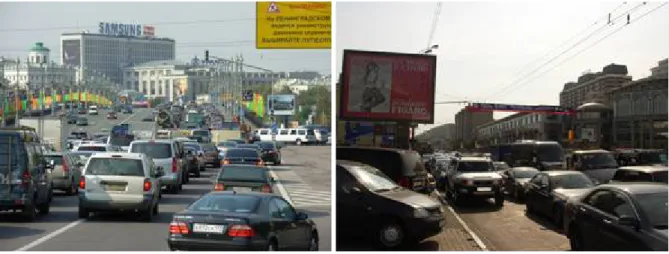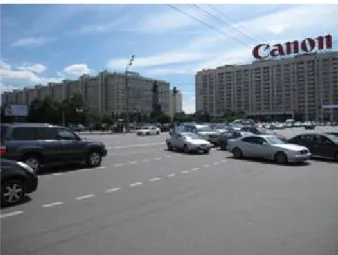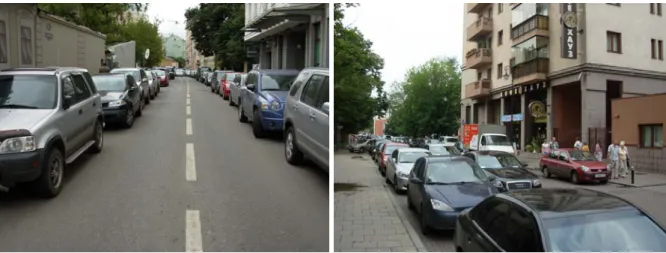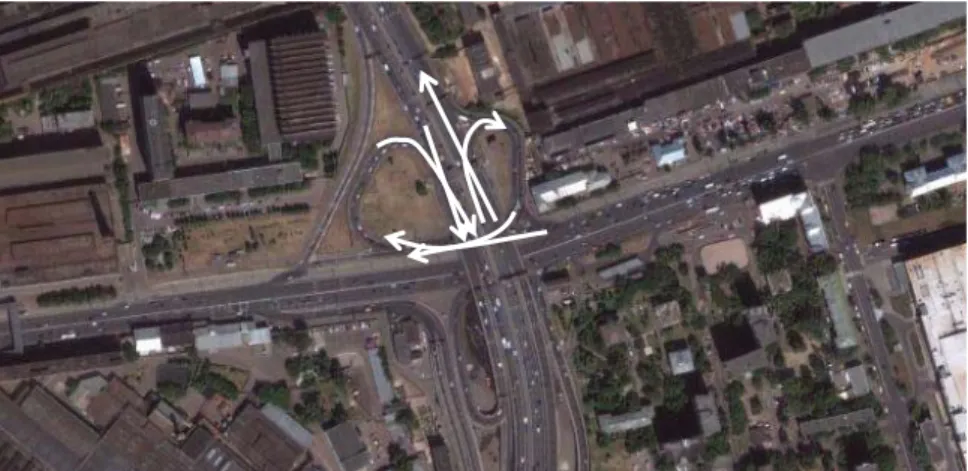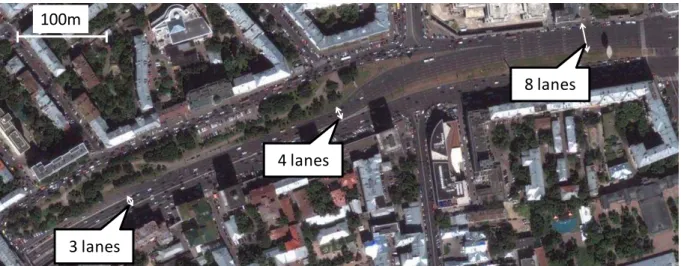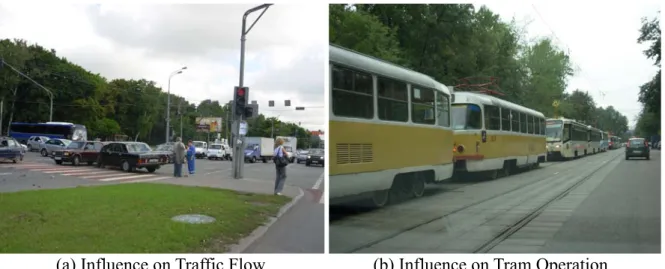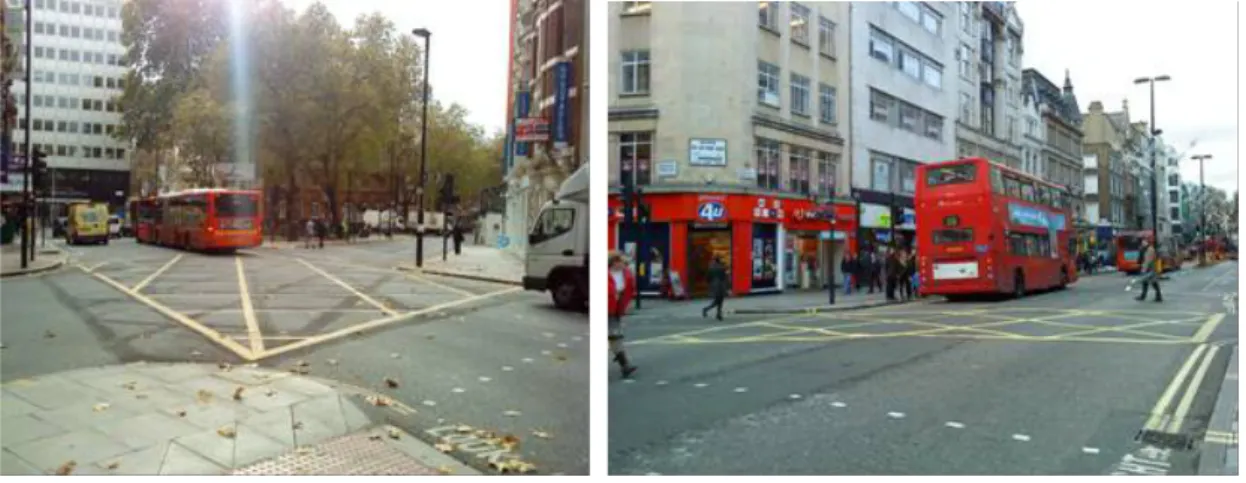1
The Traffic Situation and the Future Direction of Moscow Region
Kiichiro HATOYAMA Visiting Lecturer
Graduate School of Business Administration Moscow State University
1-44, Leninskie Gory, Moscow 119991, Russia
Fax: +7(495) 662 3201 E-mail: hatoyama@icss.ac.ru
Abstract: Moscow region in Russia has started tackling to the transport problems. Actually more than 2,500 people are killed in traffic accidents in a year in this region and it is said that the total monetary annual loss can be 1 billion dollars. This paper introduces the traffic situation in Moscow and analyzes the cause and countermeasures. The causes of traffic congestion are classified into three categories: “problems on drivers’ behavior”, “problems in transport system” and “problems in social system” And the countermeasures are classified into three categories: “traffic regulation improvement”, “infrastructure improvement” and “control and user education.” It was found that in the long run they have to construct plenty of infrastructures but on the other hand there exist plenty of devices or ideas to improve traffic situation in short term.
Key Words: Moscow, Russia, traffic congestion, driver’s behavior, transport policy
1. INTRODUCTION – Moscow as a megalopolis
Urban settlements with population over 1 million people are usually called megalopolises. Usually, megalopolises are administrative centers, major national and regional industrial, financial, cultural centers, and cities with the highest living standards. One of the main challenges under development of megalopolises is how to maintain the transport system under the growing motorization, that is to say, the process of uncontrolled growth of private cars. Initial motorization stages showed mainly positive aspects: time saving, significant increase in transport accessibility and mobility, regular and accurate delivery of passengers and cargo, growing trip comfort and so forth. However, after reaching a certain motorization level, the negative consequences have started appearing more and more intensively: death and injuries due to traffic accidents, traffic congestion, difficulty to protect public transport, the pollution of the environment and so on. Most megalopolises have been facing to this situation for a long time, since they found that the complex of transport problems would almost nullify the advantages of the car use. Global tendencies have become more apparent in Russia as well. Private car becomes an integral part of the way of life in Russia. It is said that by 2020 as many as seven out of ten Russian families will use cars. Share of private cars in the national transport balance also keeps growing. The situation is the most serious in Moscow region. 1.1 Structure of Moscow Region
Moscow region is composed of two different constituent entities of the Russian Federation: Moscow City (or simply Moscow) and Moscow Oblast. Moscow is the capital city of Russia and Moscow Oblast is located around Moscow (Figure 1). The area, the population and the car ownership rate of each entity are shown in Table 1 (Federal state statistics service, 2009 and 2010). According to this information, there are approximately 3 million private cars in
2
Moscow and 2 million in Moscow Oblast. This scale is comparable with that of Beijing in China or Tokyo in Japan. The forecast also says that the number of cars will increase up to 8 million by 2020.
30km 10km
Figure 1 Moscow and Moscow Oblast
Table 1 Basic Information of Moscow region (2010)
Moscow City Moscow Oblast
Area (1000km2) 1.1 45.8
Population (1000 persons) 10,563 6,753
Car ownership rate (per 1000 persons) (2009) 278.7 284.0
The road structure of Moscow region is “ring and radial.” The region is covered with 5 ring highways and 18 main radial highways. The total length of federal and regional automobile roads in Moscow region is 17.6 thousand km, of which federal highways account for 2,450 km (14%) and regional local roads account for 15,156 km (86%). The length of first-class automobile roads (that have 4 lanes or more) is 944 km, of which federal highways account for 789 km and regional local roads account for 155 km. About 720 km of regional local roads in Moscow Oblast are still dirt roads.
The annual average daily traffic volume in the advance sections of federal highways is extremely high; some highways carry more than 60 thousand vehicles a day and there is a highway that carries more than 130 thousand vehicles a day. One of the reasons of this high traffic volume in Moscow Oblast is a low density of automobile roads. With the motorization level of the population living within the Moscow region being comparable with the motorization level of European countries, it is obvious that more automobile roads are necessary in the Moscow region.
1.2 Traffic Situation in Moscow Region
According to the statistics provided by the State Inspection for Road Traffic Safety, Ministry of Internal Affairs (2007-2010), the situation of traffic accident in Moscow region is summarized as Table 2.
3
Table 2 The Situation of Traffic Accident in Moscow Region
# of Accident Killed Injured # of Accident Killed Injured 2007 14,939 1,161 17,022 14,337 2,866 17,682 2008 13,306 865 15,114 12,520 2,247 15,139 2009 12,445 746 14,341 11,329 1,898 14,176 2010 11,757 763 13,592 10,659 1,844 13,407
Moscow City Moscow Oblast Year
The number of accidents is now decreasing gradually. Kichedji et al. (2010) pointed out that the reason is the implementation of the federal program of “Road Traffic Safety Improvement.” However, still lots of people are killed in accidents especially in Moscow Oblast and comparing with population, 7.1 per 100,000 persons are killed in Moscow City and 28.1 persons are killed in Moscow Oblast.
Especially in Moscow City, traffic congestion has been another chronic and serious problem as is shown in Figure 2. Traffic congestion irritates drivers at a lot of road sections not only in peak hours but also in other periods of time. The most irritative thing is that they cannot forecast their travel time once they start driving. It may take two or more hours to travel between a section where you can pass through in 15 minutes if there is no congestion. According to Trofimenko’s research (2006), the annual loss of time can be calculated as 87.5 hours per person and the total monetary annual loss in Moscow City can be 31.6 billion rubles (approx. 1 billion dollars).
Figure 2 Traffic Congestion in Moscow City
To improve those situations, it is obvious that more road infrastructure should be constructed in a long run. However, considering the urgency of this problem, it is also necessary to apply countermeasures that are possible to realize in two or three years. This paper diagnoses the causes of the transport problem and considers realizable countermeasures. Since most of the causes of traffic accidents are basically included in that of traffic congestion, now the causes of traffic congestion are going to be discussed here.
2. THE MAIN CAUSES OF TRAFFIC CONGESTION IN MOSCOW
The causes of traffic congestion are classified into three categories: problems on drivers’ behavior, transport system and social system.
4 2.1 Problems on the Drivers’ Behavior
In general, the manners of Russian drivers are not so good and they tend to have a low threshold for violation of traffic law. Above all, following 5 points must be influential factors. 2.1.1 Surging into Intersections
Even when a section just after an intersection is full of traffic and it is obvious that a driver will block the intersection if entering into it, a lot of drivers tend not to stop before the intersection but to surge into it (Figure 3). As was expected, they block the intersection, disturb other traffic flows and produce unnecessary congestion.
Figure 3 Left-turning Vehicles Surging into an Intersection
Most of the drivers in Russia are not good at considering the effect of their own behavior on others and tend to think “go further if there is a space!” This psychology might be derived from the Russian social system that will be mentioned in a following section of this paper. 2.1.2 Cutting into Line
In general drivers in Moscow tend to cut into line. And they often wait in through lanes so as to cut into left or right turn lanes from there. Since in Moscow phases for left-or-right-turning vehicles are often separated from the phase for through traffic, they may block the through lanes for a long time even when the number of lane is not sufficient. Moreover, in the case of traffic congestion in through traffic, a lot of vehicles going through often wait in the left or right turn lanes to cut into the through lanes and cause unnecessary congestion.
2.1.3 Running into Narrow Streets
When facing to traffic congestion, it is typical for drivers to run into narrow streets to search other routes and this behavior may cause another traffic congestion in the narrow street. Since in Moscow the network of narrow streets is very complicated, those drivers may lose their way and cannot go back to wide roads easily. As a matter of fact, it may take more time for those drivers to pass through the narrow streets than to go straight along the wide congested streets.
2.1.4 Parking on Roads
In Moscow drivers do not care about on-street parking. Because there are less parking places than needed and the control of illegal parking is not tight at all, lots of drivers tend to double park, to park near the bus stops, intersections or where is prone to be a bottleneck (Figure 4). The vehicles searching parking place in slow speed are also problematic. Moreover, it is
5
typical for companies to employ many company drivers and they usually wait on streets, which can be one of the reasons.
Figure 4 On-street Parking and Double Parking 2.2 Problems in the Transport System
Here, I would like to introduce problems in the transport system. 2.2.1 Inadequate Infrastructure
It should be pointed out first that the rate of road area is still small and not sufficient for present huge traffic demand. Moreover, compared with the number of vehicles on the roads, the amount of parking place is desperately small. The shortage of road infrastructure may naturally cause traffic congestion, and the deficiency of parking places may increase drivers’ on-street parking.
2.2.2 Irrational Signal Phasing
This is a problem on the signal phase design. In Moscow especially at the intersections of two wide streets, complicated signal phasing is often used; left turn is not allowed, left turn and right turn are allowed only from frontage roads, and so on (Figure 5). In this case, it is often happened that not sufficient split is allocated to the frontage roads, or that some on-street parking vehicles block the traffic of frontage roads. Similar situations occur at intersections of a wide road and a narrow road; the split allocation is often not adequate and causes long queues in the narrow roads.
6 2.2.3 Heavy Use of Weaving Sections
At a lot of large intersection and interchanges of ring highway roads, many weaving sections can be observed. There are some sites where a couple of weaving sections are connected with one another (Figure 6). This situation is not desirable not only from the viewpoint of traffic congestion but also traffic safety. As a matter of fact, lots of accidents offer in those sites.
Figure 6 An Example of Concentrated Weaving Sections (photo form Google Earth) 2.2.4 Confusing Ways of Left Turn
In Moscow, the interval between two intersections is set very long and intersections where left turn is allowed are very limited. Therefore, to make a left turn, one must make several times of right turns, turn around before or after making a right turn, or enter into a frontage road before a left turn. These confusing ways of left turn may put unnecessary burdens on the other roads. This system can work only if the traffic flow is light enough. However, if traffic congestion occurs at any section, the effect might spread to all sections. Also in those areas several traffic flow lines have to cross with one another, which can be a cause of traffic accidents. Therefore, this kind of system must be reconsidered.
Figure 7 Confusing Ways of Left Turn 2.2.5 Confusing Way of Viewing Left or Right Turn Arrow
In addition to the way of left turn, it is also confusing how to look left or right turn arrows on signal lights. According to the road traffic law of the Russian Federation, if a signal light has no left or right turn arrows, then you can go to any possible directions when the light is green. However, if a signal has left or right turn arrows, you cannot go to the directions of the arrows when the arrows are not lighted even if the main signal is green (Figure 8). Therefore, every time when approaching a signal light, drivers have to confirm whether left or right turn arrows are set on it. This principle is very confusing especially at night and may cause misperception and late start. Signal lights should be design well for drivers to perceive its meaning immediately.
7
×
Figure 8 The Meaning of Signal Lights in Russia 2.2.6 Rapidly Narrowing Road Width
It is not unusual in Moscow that the width of the main road suddenly and rapidly decreases (Figure 9). This is one of the easiest-to-understand examples of bottlenecks. There, a lot of drivers on the merging lanes rush into the remaining lanes and it may cause serious congestion.
8 lanes
4 lanes
3 lanes 100m
Figure 9 An Example of Rapidly Narrowing Road Width 2.3 Problems in Social System
The last point of view is from social system. There are several problems in the social system of Moscow that have serious effects.
2.3.1 Time-Consuming Registration Process of Traffic Accidents
According to the traffic law of the Russian Federation, when a driver causes an accident, one must stop at the point and start the necessary procedure, and basically one must not leave the accident scene before the police arrive. This rule can be observed in other countries also. However, usually it takes long time until a police officer reaches the accident location. Usually one must wait for a couple of hours without moving the vehicle from the location. This situation can cause serious traffic congestion or block (Figure 10a). Although it is also written in the law that one must try to make a room for other traffic flows, it does not work well in real. The worst situation is an accident on a tramway track. In this case the operation of trams has to be stopped in several hours and stuck trams make a long queue (Figure 10b).
8
(a) Influence on Traffic Flow (b) Influence on Tram Operation Figure 10 A Traffic Accident and its Influence
2.3.2 Unexpected Roadblocks
While a VIP (with or without police escort) passes a road, the police officers always block the other traffic by their hands or by controlling all of signal lights as red. This treatment can be understandable from the viewpoint of security. The problem is that in this case no information is usually provided to drivers about how to make a detour, how long the blockage continues and so on. Under this situation, drivers cannot make any other behavior than waiting and get irritated. It may cause a dangerous situation in terms of traffic safety. These kinds of road blockage should be minimized in time.
2.3.3 Disabled Vehicles on Roads
A lot of vehicles (especially heavy) tend to be broken suddenly and need to stop on the roads. On a road of heavy traffic flow, the decrease of one lane can make a serious traffic capacity decrease and cause congestion (Figure 11). Furthermore, information about disabled vehicles is seldom provided to drivers and it is hard to know the existence of disabled vehicles in advance. One of the main reasons is that the regular safety inspection of each vehicle is not conducted properly although there is a rule about it.
9
3. POSSIBLE MEASURES AGAINST TRANSPORT PROBLEM IN MOSCOW
Major problems have been already introduced. It seems to be profound to solve those problems. However, there are also some countermeasures that are possible to realize easily. Here possible countermeasures are discussed. Basically they are classified into three categories: “traffic regulation improvement”, “infrastructure improvement” and “control and user education.”
3.1 Traffic Regulation Improvement
The first category is to improve traffic regulation.
3.1.1 To Review Signal Phase Design and Split Allocation
It is necessary to review and evaluate the adequacy of split allocation and the legibility of signal phase designing at every intersection. It is not usual in the world to use frontage roads for left turn (in the right-hand traffic). It seems to be better to rearrange this left-turn system. Before doing this it is absolutely necessary to conduct a survey to understand traffic flow at major intersections in Moscow because there are less data about it. If possible, it might also useful to introduce real-time signal controlling system by equipping detectors.
3.1.2 To Change the Policy of Left and Right Turn Arrow
It is much better to set not only green arrows but also yellow and red arrows so that drivers can easily catch the meaning of the signal (Figure 12).
×
Figure 12 Change of Policy of Signal for Turning 3.1.3 To Reduce the Road Width Gently
When the road width reduction is required, it is better not to reduce it suddenly but to do it gently. To do so, it may be possible to diversify vehicles’ merging points. This measure does not require new construction. There is also a possibility that a very wide section is inherently not necessary if the sudden reduction is unavoidable (Figure 13). In any case, surplus lands can be utilized as left or right turn pockets, parking places, bus stops, and so on.
3.2 Infrastructure Improvement
The second category is to improve the infrastructure. 3.2.1 To Equip Parking Places
First of all, it is urgently necessary to increase parking places gradually in two or three years since there are very few in the city. By conduction a survey to comprehend the present parking needs, it is possible to calculate how many parking spots are required for which part of the city. For its realization, the possible projects should be to allow to park at the places where have already used as parking place without permission, to build large structures for parking at metro or bus terminals for Park & Ride promotion, and so forth.
10
Figure 13 A Comparison of Traffic Situation under the Same Traffic Volume 3.2.2 To Equip Left Turn Pocket
In addition to the review of signal phase design, it seems to be better to equip left turn pockets at the center of main roads at intersections where the left turn was allowed only from the frontage roads. The frontage roads can be used for the right turn and through traffic only or can be utilized for the extra space for the main roads.
3.2.3 To Improve Weaving Sections
It is necessary to improve weaving sections. The simplest and most expensive way is to reconstruct the section into a grade-separated section to divide crossing traffic flows physically. Also it is said that the influence of a weaving section becomes smaller if the length of the section gets longer.
3.2.4 To Secure Escape Routes in Emergencies
It is better to secure several routes that are usually non-usable but available under the supervision of the police when the main roads are stuck by serious accidents or roadblocks. Spots where drivers can turn around or enter into frontage roads can be considered as examples.
3.3 Control and User Education
The final category is to control and educate users. 3.3.1 To Prohibit Parking within 30m from Intersections
Especially on two-lane roads, a traffic capacity is seriously damaged if there is only one car parking close to an intersection. Generally, the farther a car parks from an intersection, the smaller the effect of the parking car becomes. Therefore, for example, it may be effective if the police prohibit parking within 30m from intersections. It is also important to reduce signal cycle time of intersections so as to control the length of the queue generated in one cycle. 3.3.2 To Clarify Places where Parking is Prohibited
It is significant to clarify zones where drivers cannot enter if it is obvious that they cannot go ahead, such as inside intersections, inflow part of weaving sections and so on. If the police can control well, it is possible to reduce unnecessary traffic congestion due to the drivers’ surging behavior. In London, this system has already been implemented as “Yellow Box”
11
(Figure 14). If they stop in these boxes, the police will control immediately.
Figure 14 Yellow Boxes in London 3.3.3 To Establish a “Traffic Jam Reduction Team”
It may be effective to establish a “Traffic Jam Reduction Team” that consists of the traffic police or other private organizations with a mission to reduce traffic congestion. The main job is to control on-street parking at vulnerable sections, to restrain drivers from surging into intersections or cutting into line. To avoid bribery, it is better to employ them at a high salary. 3.3.4 To Provide Information to Drivers
It is important to provide information about traffic situations to drivers by possible means as well as ITS technologies. Especially information about unexpected event, such as accidents and roadblocks, is necessary for drivers to think about the alternative routes.
3.3.5 To Speed Up the Registration Process of Traffic Accidents
It is inevitable to consider how to speed up the registration process of traffic accidents. Minor accidents should be immediately registered to release the accident cars especially if an accident occurs at points where huge traffic congestion is expected, such as at the center of roads or inside intersections. For example, it might be possible that a police officer near the accident point should first hurry to the point and take photographs then continue the remaining procedures at different place.
3.3.6 To Practice a Campaign of “Smart Drive”
Even if a lot of above-mentioned countermeasures are put into execution, sufficient effects cannot be seen without users’ understanding and changing their own behavior. To practice a campaign can be one possible measure to realize it. It might be effective to create a slogan, a mascot and a logotype, and to use them in advertisement on TV, radio, newspapers, Internet and so forth. It is essential to make drivers understand how they are related to present traffic congestion.
4. SUMMARY
In this paper, the traffic situation of Moscow was introduced especially from the viewpoint of traffic congestion, and the main causes and possible countermeasures were discussed. It was found that in the long run they have to construct plenty of infrastructures but on the other hand there exist plenty of devices or ideas to improve traffic situation in short term. Moscow
12
City and Moscow Oblast should take long term and short term measurements in a balanced manner. Actually, in 2010 the last mayor of Moscow City was fired suddenly in September by the President Medvedev and a new mayor has come with a special assignment of traffic congestion reduction from the President. In November 2010, they released the list of holistic countermeasures composed of more than 120 items. However they lack an effective strategy so far. Therefore we should carefully monitor how they realize the items in a balanced manner.
Other than traffic congestion, there are still problems in logistics, public transport services, ITS realization and so on. It is safe to say that there will be a lot of research topics in Moscow Region from now on.
REFERENCES
Federal state statistics service [Федеральная служба государственной статистики] (2010) Russian statistical yearbook [Российский статистический ежегодник].
Federal state statistics service [Федеральная служба государственной статистики] (2009) Transport in Russia [Транспорт в России].
Departament of ensuring road traffic safety of Ministry of internal affairs [Департамент обеспечения безопасности дорожного движения Министерства внутренних дел] (2007-2010) Accident Statistics [Статистика аварийности] (in Russian).
Kicheji, V. N. and Hatoyama, K. (2010) Moscow: Transport Problems in a Megalopolis [Москва: транспортные проблемы мегаполиса], DPR Press (in Russian).
Trofimenko, Y. V. and Yevgeniev, G. I. (2006) Echology : Transport Construction and Environment [Экология : Транспортное сооружение и окружающая среда], Akademia (in Russian).
Road Traffic Law of the Russian Federation [Правила Дорожного Движения Российской Федерации] http://www.prav-net.ru/pdd-2008-pravila-dorozhnogo-dvizheniya-2008/

